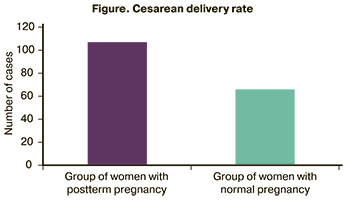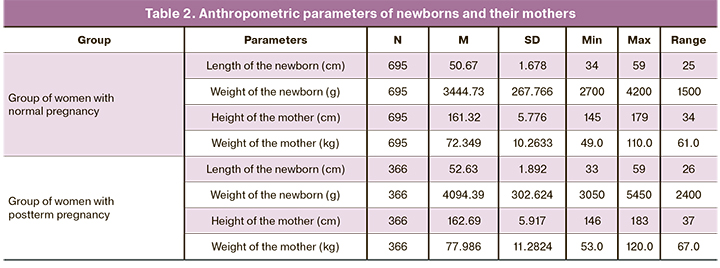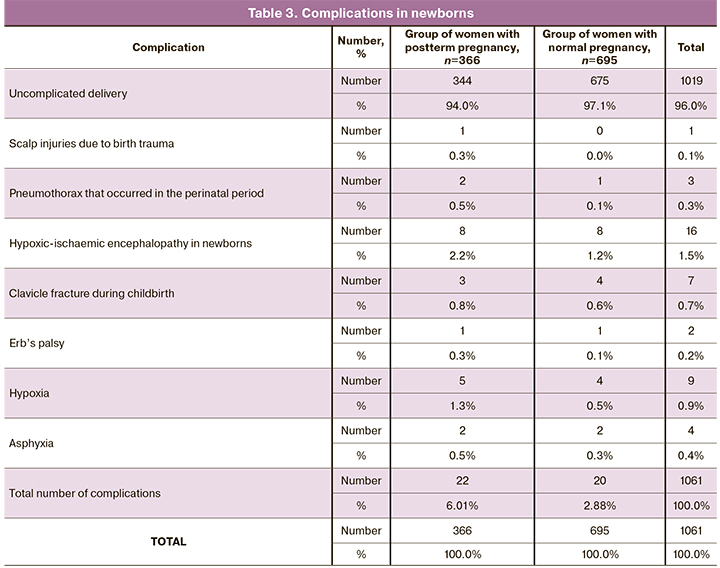The course of labor in postterm pregnancy in Mongolian women
Objective. To study and compare the characteristics of the course of labor in women who had a postterm pregnancy.Saruulsaykhan Erdenebat, Enkhtsetseg Jamsranjav, Enebish Sundui, Amgalanbaatar Dorjkhuu
Materials and methods. Information for studying the characteristics of the course of labor was obtained from 366 mothers who had a postterm pregnancy and 695 mothers whose pregnancy was normal. All women gave birth in 2017-2018. The data were processed using the IBM SPSS 23 software package.
Results. Fetal hypoxia was observed in 67 cases in the group of patients with a postterm pregnancy and in 52 women whose pregnancy was normal; oligohydramnios was revealed in 81 cases in the group of patients with a postterm pregnancy (p=0.000). Cephalopelvic disproportion was observed in 59 women with a postterm pregnancy and in 45 women whose pregnancy was normal (p=0.000). The women with postterm pregnancy had fetal distress more often than those with normal pregnancy (p=0.000). Cesarean section was more common in women with postterm pregnancy, namely, 107/366 (29.23%) patients compared to 66/695 (9.49%) women with normal pregnancy, (p=0.000). The mean length of the newborn in the group with a postterm pregnancy was 52.63 (1.89) cm, and it was 50.67 (1.68) cm in women with a normal pregnancy; the mean weight of the newborn in the group with a postterm pregnancy was 4094.39 (302.624) g, and in women with a normal pregnancy it was 3444.73 (267.766) g (p=0.000). The mean height of the mother in the group with a postterm pregnancy was 162.69 (5.917) cm, and in case of a normal pregnancy it was 161.32 (5.776) cm; the mean weight of the mother in the group with a postterm pregnancy was 77.986 (11.282) kg, and in case of a normal pregnancy it was 72.349 (10.263) kg (p=0.000). The analysis of the course of labor revealed a greater number of complications in women with a postterm pregnancy than in women whose pregnancy was normal (p=0.000).
Conclusion. The course of labor in women who had a postterm pregnancy is characterized by numerous complications: fetal hypoxia, oligohydramnios, fetal distress, birth trauma, as well as a high frequency of cesarean section.
Keywords
According to the World Health Organization and the International Federation of Gynecology and Obstetrics, postterm pregnancy is defined as pregnancy that lasts 42 weeks or 294 days or more from the first day of the last menstrual period. Post-dates pregnancy is defined as lasting 40 weeks plus one or more days. Prolonged pregnancy is any pregnancy after 42 weeks and is synonymous with postterm pregnancy [1, 2].
Postterm pregnancy is a serious problem in obstetric practice, which results in congenital malformations, perinatal mortality and postpartum bleeding.
Birth after postterm pregnancy is called postterm birth.
According to our researchers, postterm pregnancy accounts for 6% of all births in Mongolia [3].
One of the most relevant problems of obstetrics in Mongolia is the timely identification of women at 41 weeks gestation who are at risk for postterm pregnancy, management of labor, and the study of complications of postterm pregnancy [4, 5]. Obstetrician-gynecologist Khishgee S. works at the National Maternal and Child Health Research Center. She conducted a study among a large number of pregnant Mongolian women and published the results in the quarterly journal of the Mongolian Association of Obstetrics and Gynecology [5].
The aim of the research is to study and compare the characteristics of the course of labor in women who had a postterm pregnancy.
Materials and Methods
In order to study the course of labor in women who had a postterm pregnancy in comparison with women whose pregnancy was normal, information was obtained from 366 mothers with a postterm pregnancy and 695 mothers with a normal pregnancy. The women gave birth at the National Maternal and Child Health Research Center and in the Urguu, Khuree and Amalgan maternity hospitals located in the capitalal of the country. The study was prospective.
Statistical analysis
The arithmetic mean (M) and standard deviation (SD), M (SD) were used in the description of the statistical analysis indicators. The qualitative indicators are given in absolute and relative values (%). To compare the frequency of occurrence of variables in the study groups, the χ2 criterion was used for the 2×2 contingency tables. Student’s t-test was used to assess the statistical significance of the differences between the parameters [6].
Statistical processing of the obtained results was performed using the IBM SPSS 23 software package [7]. For all types of analysis, a p value of <0.05 was considered to be statistically significant.
Results
Among the study participants, there were 695 women (65.5%) whose pregnancy was normal, and 366 women (34.5%) who had a postterm pregnancy. Gestational age was determined not in days, but in weeks plus days. The mean gestation period of the women who had a postterm pregnancy was 41.15 weeks, and the mean gestation period of the women who had a normal pregnancy was 39.52 weeks.
According to the results of the study, there was a correlation between the gestation period and Apgar score of the newborns: the longer the gestation period, the lower Apgar score the newborns had.
A vacuum extractor was used in three normal pregnancies and six postterm pregnancies.

As can be seen from Table 1, fetal hypoxia was revealed in 67 cases in the group of women with a postterm pregnancy and in 52 cases in the group of women with a normal pregnancy, the difference was statistically significant (p=0.000). Oligohydramnios was diagnosed in 81 cases in the group of women with a postterm pregnancy, the difference was statistically significant (p=0.000).
 Pelvic dimensions are of great importance for the course and outcome of labor. If maternal pelvic dimensions are normal, cephalopelvic disproportion may occur due to a large fetus, postterm pregnancy, etc. In our study, cephalopelvic disproportion was identified in 59 women with postterm pregnancy and 45 women with normal pregnancy; the difference was statistically significant (p=0.000). According to our study, fetal distress occurred more frequently in the group of women with a postterm pregnancy than in the group of women with a normal pregnancy (p=0.000).
Pelvic dimensions are of great importance for the course and outcome of labor. If maternal pelvic dimensions are normal, cephalopelvic disproportion may occur due to a large fetus, postterm pregnancy, etc. In our study, cephalopelvic disproportion was identified in 59 women with postterm pregnancy and 45 women with normal pregnancy; the difference was statistically significant (p=0.000). According to our study, fetal distress occurred more frequently in the group of women with a postterm pregnancy than in the group of women with a normal pregnancy (p=0.000).
Of all 173 women who had a cesarean section, cesarean delivery was more common in women with postterm pregnancy, namely, 107/366 (29.23%) patients compared to 66/695 (9.49%) women with normal pregnancy, the difference was statistically significant (p=0.000) (Figure).
Anthropometric parameters were compared in newborns and their mothers with a postterm pregnancy and with a normal pregnancy (Table 2). Student’s t-test was used to compare two groups.

The mean length of the infants born to mothers with a postterm pregnancy was 52.63 (1.89) cm and ranged from 33 to 59 cm, in group of women with a normal gestation period it was 50.67 (1.68) cm and ranged from 34 to 59 cm (p=0.000).
The mean weight of the infants born to mothers with a postterm pregnancy was 4094.39 (302.624) g and ranged from 3050 to 5450 g, in group of women with a normal gestation period it was 3444.73 (267.766) cm and ranged from 2700 to 4200 g (p=0.000).
Delivery of the large fetus (more than 4000 g) was revealed in 91/366 (24.86%) cases in the group of women with a postterm pregnancy, and it was observed in 192/695 (27.63%) cases in the group of women with a normal pregnancy.
The average height of the mother in the group with a postterm pregnancy was 162.69 (5.917) cm and ranged from 146 to 183 cm, and in the case of a normal pregnancy it was 161.32 (5.776) cm and ranged from 145 to 179 cm (p=0.000).
The average weight of the mother in the group with a postterm pregnancy was 77.986 (11.282) kg and ranged from 53.0 to 120.0 kg, and in the case of a normal pregnancy it was 72.349 (10.263) kg and ranged from 49.0 to 110.0 kg (p=0.000).
The analysis of the course of labor revealed a greater number of complications in the group of women with a postterm pregnancy than in women whose pregnancy was normal (p=0.000). The frequency of shoulder dystocia was not known.
Therefore, postterm pregnancy is one of the causes of birth complications in women.

Discussion
According to the literature, the course of pregnancy and labor in women with a postterm pregnancy is characterized by a high percentage of complications (preeclampsia, anemia, cephalopelvic disproportion, hypoxia, and fetal asphyxia) [8–11].
A statistically significant difference in the incidence of fetal hypoxia and fetal distress between the groups with a postterm and normal pregnancy was noted in our study; this shows that the incidence of fetal complications increases in women with a postterm pregnancy. The terms ‘hypoxia’, ‘asphyxia’ and ‘fetal distress’ imply the following. Fetal hypoxia refers to a lack of oxygen during pregnancy. Cardiotocography is used to diagnose fetal hypoxia. Asphyxia is an oxygen starvation of the child or suffocation caused by compression of the airways and closing the lumen of the respiratory tract during childbirth. Fetal distress refers to a condition when the fetus does not receive enough oxygen; it usually occurs if the pregnancy lasts for an extended period or due to other complications. Cesarean delivery is indicated in case of fetal distress which is based on abnormal cardiotocography.
The results of our study show that the incidence of fetal complications in Mongolian women with postterm pregnancy is consistent with the results of other researchers. For example, according to Tongsong T. and Srisomboon J. (2004), fetal distress during childbirth and a decrease in the amniotic fluid index are observed in 90.87% of postterm pregnancies and in 72.73% of normal pregnancies [12]. According to Kiselevich M.F. et al., the course of pregnancy and labor in women who have postterm pregnancy is characterized by a high rate of complications, namely, 76.7 (2.09)% and 80.8 (2.16)%, respectively [13].
According to the results of our study, the postterm pregnancy is one of the causes of the increase in the length and weight of the newborn. We compared our results with those of other studies. Thus, the analysis of Avanesyants A.S. et al. showed that the weight of newborns after postterm pregnancy had the following indicators: 20% (6) of newborns had a weight of 2501–3000 g, 46.7% (14) – 3001–3500 g and 33.3% (10) – 3501–4000 g [14]. The results are mostly consistent with our data.
We also obtained statistically significant differences in the values of the mean weight between women with a postterm pregnancy and women with a normal pregnancy. The results of some similar studies confirm this fact. For example, Sahlin L. et al. suggest that obesity is a risk factor for postterm pregnancy [15].
Conclusion
The course of labor in women with postterm pregnancy is characterized by numerous complications: fetal hypoxia, oligohydramnios, fetal distress, birth trauma, as well as a high frequency of cesarean deliveries.
References
- Health development center. Health indicators. Ulaanbaatar; 2015.
- https://www.ausmed.com/cpd/articles/post-term-pregnancy.
- Solongo Ts. On the issue of perinatal mortality in the western region of Mongolia. Ulaanbaatar: Mongolian National University of Medical Sciences; 2016.
- Hannah M.E., Hannah W.J., Hellmann J., Hewson S., Milner R., Willan A. Induction of labor as compared with serial antenatal monitorng in post-term pregnancy. N. Engl. J. Med. 1992; 326(24): 1587-92. https:dx.doi.org/10.1056/NEJM199206113262402.
- Khishgee S. Obstetric problems. A quarterly journal of the Association of Obstetricians and Gynecologists. 2015; 1(3): 17-30.
- Лакин Г.Ф. Биометрия. Учебное пособие для биологических специальностей вузов. 4-е изд. М.: Высшая школа; 1990. 352 с. [Lakin G.F. Biometrics. Textbook for the biological specialties of universities, 4th ed. Moscow: The Higher School; 1990. 352 p. (in Russian)].
- http://www.datuapstrade.lv/rus/spss/
- Караганова Е.Я., Орешкина И.А. Перинатальные исходы запоздалых родов. Вопросы гинекологии, акушерства и перинатологии. 2003; 2(5): 52-6. [Karaganova E.Ya., Oreshkina I.A. Perinatal outcomes of post-term births. Questions of gynecology, obstetrics and perinatology. 2003; 2(5): 52-6. (in Russian)].
- Габриелян А.Р. Современные аспекты акушерской тактики при переношенной беременности: дис. ... канд. мед. наук. 2005. 155 с. [Gabrielyan A.R. Modern aspects of obstetric tactics in post-term pregnancy: dissertation of the candidate of medical sciences. 2005. 155 p. (in Russian)].
- Baskett T.F., Allen V.M., O’Conell C.M., Allen A.C. Predictons of respiratory depression at birth in the term infant. BJOG. 2006; 13(7): 769-74. https:dx.doi.org/10.1111/j.1471-0528.2006.00987.x.
- Сичинава Я.Г., Сангалова Е.Н. Состояние шейки матки при переношенной беременности. Прогнозирование и исходы родов. Вопросы гинекологии, акушерства и перинатологии. 2007; 6(6): 21-4. [Sichinava Ya.G., Sangalova E.N. The condition of the cervix during post-term pregnancy. Prediction and outcomes of childbirth. Questions of gynecology, obstetrics and perinatology. 2007; 6(6): 21-4. (in Russian)].
- Tongsong T., Srisomboon J. Amniotic fluid volume as a predictor of fetal distress in postterm pregnancy. Int. J. Gynecol. Obstet. 1993; 40(3): 213-7. https:dx.doi.org/10.1016/0020-7292(93)90833-i.
- Киселевич М.Ф., Киселевич М.М., Киселевич В.М., Курочко А.А., Смирнова В.А. Течение родов у женщин с переношенной беременностью. Научные ведомости БелГУ. Серия Медицина. Фармация. 2013; 25: 141-4. [Kiselevich M.F., Kiselevich M.M., Kiselevich V.M., Kurochko A.A., Smirnova V.A. The course of labor in women with post-term pregnancy. Scientific statements of the Belgorod State University. Series: medicine. Pharmacy. 2013; 25: 141-4. (in Russian)].
- Аванесянц А.С., Гетажеев К.В., Карапетян Д.А., Тебиев И.А., Торчинова Р.З. Переношенная беременность (запоздалые роды): течение, осложнения, исходы. Молодой ученый. 2018; 40: 109-11. Available at: + https://moluch.ru/archive/226/52904/ [Avanesyants A.S., Getazheev K.V., Karapetyan D.A., Tebiev I.A., Torchinova R.Z. Post-term pregnancy (postterm births): course, complications, outcomes. Young Scientist. 2018; 40: 109-11. Available at: https://moluch.ru/archive/226/52904/ (in Russian)].
- Roos N., Sahlin L., Ekman-Ordeberg G., Kieler H., Stephansson O. Maternal risk factors for postterm pregnancy and cesarean delivery following labor induction. Acta Obstet. Gynecol. Scand. 2010; 89(8): 1003-10. https:dx.doi.org/10.3109/00016349.2010.500009.
Received 01.04.2021
Accepted 26.04.2021
About the Authors
Saruulsaykhan Erdenebat, Mongolian National University of Medical Sciences, Ulaanbaatar, Mongolia. E-mail: fbm16f005@gt.mnums.edu.mn. ORCID: 0000-0003-4121-5326.Enkhtsetseg Jamsranjav, Mongolian National University of Medical Sciences, Ulaanbaatar, Mongolia. E-mail: enkhtsetseg@mnums.edu.mn. orcid: 0000-0001-6343-8200.
Enebish Sundui, Mongolian National University of Medical Sciences, Ulaanbaatar, Mongolia. E-mail: enebish@mnums.edu.mn. ORCID: 0000-0002-4294-9180.
Amgalanbaatgar Dorjkhuu, Mongolian National University of Medical Sciences, Ulaanbaatar, Mongolia. E-mail: amgalanbaatar.dorjkh@gmail.com.
ORCID: 0000-0001-8009-880X.
For citation: Saruulsaykhan Erdenebat, Enkhtsetseg Jamsranjav, Enebish Sundui, Amgalanbaatar Dorjkhuu. The course of labor in postterm pregnancy in Mongolian women.
Akusherstvo i Ginekologiya / Obstetrics and gynecology. 2021; 5: 108-112 (in Russian)
https://dx.doi.org/10.18565/aig.2021.5.108-112



